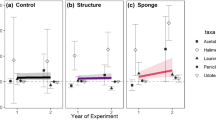Abstract
Sponge harvesting was a significant part of the Bahamian economy until the late 1930s when disease, hurricanes, and unsustainable harvesting practices reduced the viability of the sponge industry. Current international demands for natural products, increasing regional needs for economic diversification, and the historical foundation of sponging in The Bahamas makes sponge aquaculture a desirable candidate as a sustainable industry. To determine the feasibility of sponge aquaculture in The Bahamas, we deployed growout arrays between February 2006 and September 2009 at two sites off South Eleuthera to examine the survival and growth rates of grass sponge (Spongia tubulifera) and hardhead sponge (Spongia pertusa) cuttings. Complete skin regeneration occurred for both species by the second week following deployment. Following 43 months of growout, both grass and hardhead sponges showed significant positive growth, with cuttings of both species exhibiting faster growth trajectories at the more protected site (Site A) when compared with the site further from shore (Site B). The proportion of sponge cuttings lost during the course of the study was also considerably less for both species at Site A, as was the amount of required maintenance for the arrays. The initial deployment of larger sponge cuttings could help reduce the overall growout period, as would the selection of sites that offered more protection for growout. Based on these results, sponge aquaculture could prove to be a sustainable low-cost industry in The Bahamas; however, further research on site selection, regulations, and market acceptability remains to be done.


Similar content being viewed by others
References
Albury P (1975) The story of the Bahamas. Macmillan Education Ltd, London
Bahamas Environment, Science, and Technology Commission (BEST) (2005) State of the environment. Government of the Bahamas
Belarbi EH, Gómez AC, Chisti Y, Camacho FC, Grima EM (2003) Producing drugs from marine sponges. Biotechnol Adv 21:585–598
Bonham C (2006) The impact of 9/11 and other terrible global events on tourism in the United States and Hawaii. J Trav Res 45:99–110
Buchan KC (2000) The Bahamas. Mar Pollut Bull 41:1–6
Casson L (1991) The ancient mariners. Princeton University Press, Princeton
Corfield GS (1938) Sponge industry of the Caribbean area. Econ Geog 14:201–206
Cotte J (1908) Sponge Culture. Fourth International Fishery Congress, Washington
Craton M, Saunders G (1998) Islanders in the stream: a history of the Bahamian people, vol 2. University of Georgia Press, Georgia
Danylchuk AJ (2005) Fisheries management in South Eleuthera: can a marine reserve help save the ‘holy trinity’. Proc Gulf Caribb Fish Inst 56:169–177
Duckworth A (2009) Farming sponges to supply bioactive metabolites and bath sponges: a review. Mar Biotechnol 11:669–679
Duckworth A, Battershill C (2003) Sponge aquaculture for the production of biologically active metabolites: the influence of farming protocols and environment. Aquaculture 221:311–329
Duckworth AR, Battershill CN, Berquist PR (1997) Influence of explant procedures and environmental factors on culture success of three sponges. Aquaculture 156:251–267
Knowles LJ (1974) The sponge industry. The Exhibition of Historical Documents Held at the Public Records Office, Ministry of Education and Culture. Nassau, Bahamas, pp 5–34
MacMillan SM (1996) Starting a successful commercial sponge aquaculture farm. Center for Tropical and Subtropical Aquaculture, University of Hawaii, Publication no. 120
Moore HF (1908) A practical method of sponge culture. Fourth International Fishery Congress, Washington
Munro MHG, Blunt JW, Dumdei EJ, Hickford SJH, Lill RE, Battershill CN, Duckworth AR (1999) The discovery and development of marine compounds with pharmaceutical potential. J Biotech 70:15–25
Osinga R, Tramper J, Wijffels RH (1999) Cultivation of marine sponges. Mar Biotech 1:509–532
Pronzato R (1999) Sponge-fishing, disease and farming in the Mediterranean Sea. Aquat Conserv Mar Freshw Ecosyst 9:485–493
Smith FGW (1941) Sponge disease in British Honduras, and its transmission by water currents. Ecology 22:415–421
Stevenly J, Sweat D (1985) Survival and growth of cut vs hooked commercial sponges in the Florida Keys. Florida Sea Grant College Technical Paper 38
Storr JF (1964) Ecology of the Gulf of Mexico commercial sponges and its related fishery. US Fish and Wildlife Service, Special Scientific Report, Fisheries No. 466
Webster NS (2007) Sponge disease: a global threat? Environ Microbiol 9(6):1363–1375
Wiedenmayer F (1977) Shallow-water sponges of the western Bahamas. Naturalhistorisches Museum, Basel
Wulff JL (2007) Disease prevalence and population density over time in three common Caribbean coral reef sponge species. J Mar Biol Assoc UK 87:1715–1720
Wurts W (2000) Sustainable aquaculture in the twenty-first century. Rev Fish Sci 8:141–150
Acknowledgments
We would like to formally dedicate this publication to Giusto Pesle, coauthor, mentor, and friend, who sadly passed away during this study while doing what he loved most—working with sponges. We would also like to gratefully acknowledge the Clarence and Ann Dillon Dunwalke Trust, the Cape Eleuthera Foundation, and the government of Trieste, Italy for financial and logistical support of this project. Many thanks also to the students and staff of The Island School and Cape Eleuthera Institute who dedicated time and energy toward making this research possible.
Author information
Authors and Affiliations
Corresponding author
Rights and permissions
About this article
Cite this article
Oronti, A., Danylchuk, A.J., Elmore, C.E. et al. Assessing the feasibility of sponge aquaculture as a sustainable industry in The Bahamas. Aquacult Int 20, 295–303 (2012). https://doi.org/10.1007/s10499-011-9457-5
Received:
Accepted:
Published:
Issue Date:
DOI: https://doi.org/10.1007/s10499-011-9457-5




